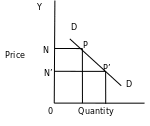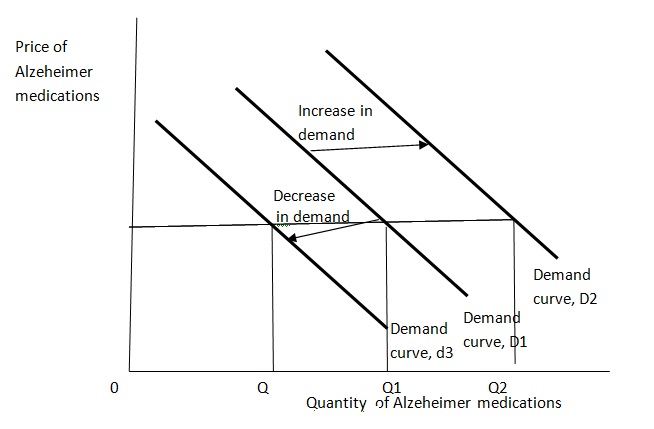Introduction
A quantity is the effect of a given intensity of demand upon the amount of a commodity that will be brought over a certain range of prices. Generally less of a commodity will be sold at a high price than at a low price this is because, as price falls more people can make their wants effective, but as price raises only those within the higher income groups continue to afford to purchase (Mankiw, N. G. 2006).
The sum that a customer pays for a particular product or service is its price. This sum is determined by varying factors which entails product identity, competition, market share and the supposed value of the product or service by the customer (Barlon, 2006). The product to be considered is produced by Alzheimer medication and this is product is influenced by many factors not only the cost access and supply. Other factors that affect the demand of the product include social factors, demand factors and economic factors which can be subdivided into advertising, change in population, change in real disposable income, Change in wealth distribution, changes in the prices of competitors’ productions, inflation rates in the market and government policy (Getzen, T.E. 2007).
Medical products are a necessity they can only be affected by the availability of substitutes in the market and it is this substitute that will affect the demand. Medical services are always relatively inelastic because people must fall sick at any time. It is only the will swift to the alternative but they will not abandon the product wholesomely. Therefore the changes in price of the product will produce a less than proportionate change in the quantity demand Alzheimer medications. The following chart shows how demand for this product is relatively inelastic (Mankiw, N. G. 2006).

From the chart above, I can comfortably say that when the price for the medical services changes, the quantity demanded is changed positively or negatively depending on changes in the price.
Factors impacting consumer demand
Changes in disposable income
This product will be affected if there is a change in disposable income of the consumer. If disposable income for consumers decreases especially this period of economic downtown we mean that the consumers will have less to spend and thus they will buy the medics that are cheap. In this case, they will move to those products or those products that are cheaper Alzeheimer medications. This will mean that the demand will fall, as well as the quantity demanded. However, if the price is changed downward, to the level of substitutes then the demand will remain with little effect(Mankiw, N. G. 2006).
Price of substitutes
Another factor that will affect the supply of Alzeheimer medications is the demand for substitutes. If substitutes are cheaper than Alzeheimer medications then they will be purchased and leave the product to themselves(Mankiw, N. G. 2006).
Changes in wealth distribution
When wealth is more evenly distributed the goods demanded by the people who have acquired more wealth will increase and the demand of the people who have lost wealth will decrease (Getzen, T.E. (2007),.
Anticipated price rises
Sometimes rumors and general speculation about tax changes e.t.c. of future shortages or abundance cause the present pattern of demand to change(Mankiw, N. G. 2006)..
Diseases
Unlike ordinary product as Alzheimer medications products will be affected by the diseases if there will be no disease then the product will not be demanded. However the disease plays an important role in ensuring that the product is purchased. Apart from diseases, consumer behavior, such as the needs of the consumer as well as what the consumer wants from the medication will ensure that the product will be highly purchased Getzen, T.E., 2007). If the consumer creates a negative attitude towards the product the consumer will move to the substitute product and this will ensure that the demand curve takes the following format.

The quantity will continue coming down if the price remains the same. Assume the income came down and quantity demanded reduced from Q to Q1. And the price remained the same. It is a clear show that the changes in the demand were not due to price changes but were due to income levels changes (Mankiw, N. G. 2006).
Coming back to demand factors I can distinguish between:- Individual modifying demand factors , such as the physical characteristics of the individual customer, individual consumer, individual reactions to sensory perceptions, individuals ethical and moral values and conceptions, intellectual capacities and general individual motivations (Barlon, K. 2006).
Social demand factors derive from the fact that consumer units live in a particular social environment and react to influences and stimuli emanating from the actions of other persons or groups, irrespective of whether they are members of a family, a particular group, a wider community or even the nation as a whole. The economic position of consumers as well as the legal socio-cultural factors can influence consumer behavior. Interpersonal and group influences in turn mainly derive from the following phenomena: the basis need of human beings for achievement; the need to feel equal and the need to show off and demonstration (Chekitan S. D and Schultz, D. E 2005):
Economic demand factors include disposable income relative prices at any point in time; the influence of advertising on consumer behavior consumer credit facilities and certain technological and economic developments. Amongst these factors purchasing power is of primary importance. The conscious concrete needs of consumer units can regardless of the variety of factors which create and modify such needs can only be converted into effective demand when they are supported by this factor, namely purchasing power. Purchasing power is a conditioning and provisory factor in effective consumption and business success. The causative factors in a specific expenditure pattern must however be sought elsewhere, namely in the dynamics of the community and especially in the group context of both the consumer and the entrepreneur(Barlon, K., 2006).
Conclusion
In order to reduce the impact of the factors mentioned above organizations should create relationships with the partners as an approach of improving its consumer consumption. It has been suggest that creating a good relationship with partners has got strategic implication for organizations. With rapid changes that takes place especially in the health industry Chekitan and Schultz (2005) suggest that health care providers need to shift and create a relationship approach in marketing.
The company has created such relationship because it has realized that the today’s market is a complex system of industries which depend on one another. The company examines this system in order to identify and exploit market opportunities. To purse this aspect the health care medication producer has partnerships such as strategic alliance, joint ventures with universities, other research organizations as well as other health care providers. All these measures are undertaken to help in the marketing of the company’s products and services (Chekitan S. D and Schultz, D. E 2005).
References
Barlon, K. (2006): The concept of the marketing mix Presentation on marketing management, Vol. 1, Oulu University -Finland.
Chekitan S. D and Schultz, D. E (2005): In the Mix: A Customer-Focused Approach Can Bring the Current Marketing Mix into the 21st Century, Marketing Management v.14.
Getzen, T.E. (2007), Health economics and financing (3rd ed.) Hoboken, NJ: John Wiley and Sons, Inc.
Mankiw, N. G. (2006); Principles of Economics; Thompson South-Western; 4th edition.